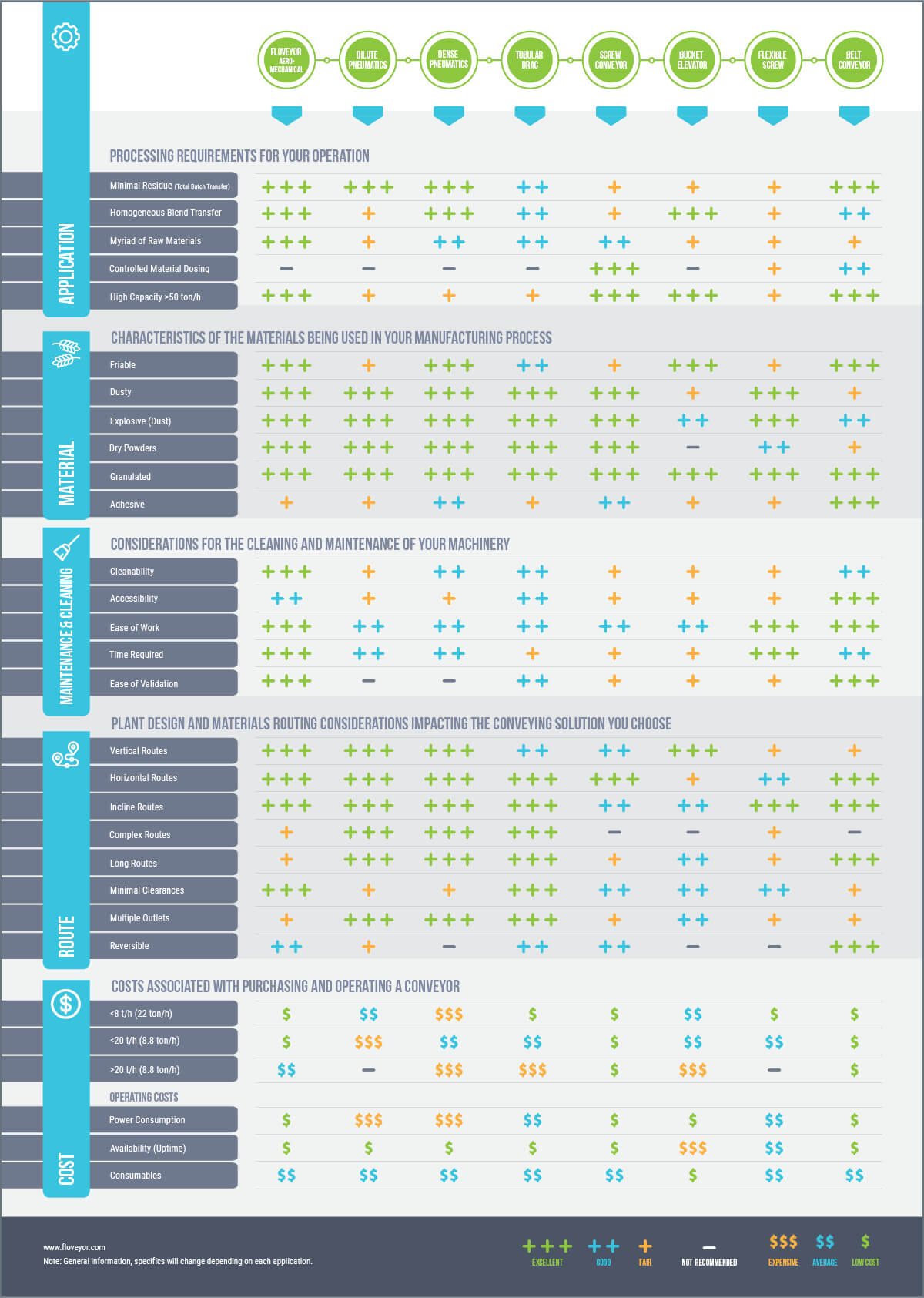A powder conveying system is a long-term investment for plants of all types. When determining costs, both capital expenditure (CAPEX) and operational expenditure (OPEX) are taken into consideration. Determining the total cost of ownership – especially over the lifetime of a plant – isn’t always straightforward. In this guide, we’ll explore some of the hidden costs associated with powder processing equipment. Depending on your location and your industry, you may incur significant OPEX charges that make the cost of a particular powder conveyor less attractive than originally thought.
Common known costs attached to a powder conveying system
- Initial purchase price: The price you pay a vendor for a new or used powder conveying system.
- Installation: The cost of installing and testing equipment to ensure it’s operating as intended. This can include changes needed to brownfields process lines to ensure new equipment can be integrated.
- Ancillary components: Mechanical equipment needed to support your powder handling system, which can include dust filters, pumps, hoppers, blowers and heating equipment.
- Replacement parts: With most conveying equipment, it’s easy to predict how often you need to replace worn parts, including drag chains, rope assemblies, buckets, seals or sprockets.
- Power consumption: The price of energy bills associated with operating your powder handling solution.
- Planned downtime: The time it takes to clean and maintain your powder handling equipment to ensure it operates efficiently, product integrity is not compromised and availability remains high.
- Unplanned downtime: The length of time your process line is out of operation due to mechanical failure, unscheduled maintenance or other unexpected issues that need to be resolved before safe operation can continue. By nature, unplanned downtime may be hard to predict but it’s not considered a hidden cost.
- Maintenance manpower: The costs required to employ operators or other staff to ensure your equipment is operating at peak efficiency.
Environmental hidden costs of powder processing equipment
As industry moves towards ESG initiatives – and how to address rising energy costs and new environmental regulations to reduce carbon emissions – energy usage is one of those hidden costs that is going to continue to be under the spotlight.
Floveyor aero-mechanical conveyors (AMC) with FloDisc® Technology are incredibly energy efficient when compared to another powder conveying system. This results in a smaller environmental footprint. For illustration purposes, we’ll compare a Floveyor aero-mechanical conveyor with a pneumatic conveyor in the following examples.
炭素排出量
As every application is unique, and the C02 emissions from electricity generation differ worldwide, it is difficult to pinpoint the sustainability impact accurately for every installation. You need to consider if your power is generated by coal, oil, gas or a renewable energy like solar, wind and hydro. You can calculate how much carbon you’re emitting with your powder conveyor based on how much energy you’re consuming and what type.
For example, when transferring granulated sugar at 20,000kg/h, a Floveyor AMC runs on a 5.5 kW drive. A pneumatic conveyor requires a 45 kW drive. Using an Australian blended rate of 0.65kg/kWh for C02 emissions from electricity generation, the benefits to the environment are rapidly realised.
エネルギー使用量
Increasingly, energy efficiency is one of the top reasons people select an AMC powder transfer solution. With energy costs soaring, the energy savings from a Floveyor AMC directly translate to reduced electricity costs. For example, at an average Australian rate of $0.34/kWh, Floveyor customers save over $50,000/year in operational expenses from operating just one AMC.
Energy taxes
Another hidden cost related to energy is consumption taxes levied by governments. Energy taxes are an important source of their revenue to cover the external costs associated with a given commodity. Increasingly, countries are using excise taxes to encourage both individuals and industry to use less fossil fuel energy sources. Environmental taxes are designed to deter sulphur or carbon use, energy security taxes, or “social” taxes to subsidise access to energy for all.
水
In most instances Floveyor powder handling equipment can be dry cleaned. If it needs cleaning at all, no water is required to clean AMC machinery. This is becoming increasingly important as the world battles severe water shortages. Global water bill increases over the past 10 years were driven largely by higher wastewater charges, something that hits industry particularly hard. These charges are meant to cover the costs of investment in environmentally sound water treatment and disposal. It’s not unusual in OECD countries to pay more to get rid of wastewater than to bring in drinking water.
Fines, penalties and reputational damage
The US and the EU are leading the world on demanding industry to measure and report against ESG targets. Legislation like the EU’s Corporate Sustainability Reporting Directive demands environmental due diligence. Other countries and regions are following suit. Not complying with reporting or failing to meet targets can result in financial penalties. Intangible costs can be harder to gauge but shareholders and the public are increasingly vocal about their expectations for industry to meet ESG targets. The prospect of reputational damage is growing and can affect company revenue or share price.
Case study: Environmental costs when conveying granulated sugar
This data graphic shows how environmental costs impact a typical food and beverage conveying application for sugar. In this example, an aero-mechanical conveying system is compared to a semi-dense phase pneumatic conveyor.
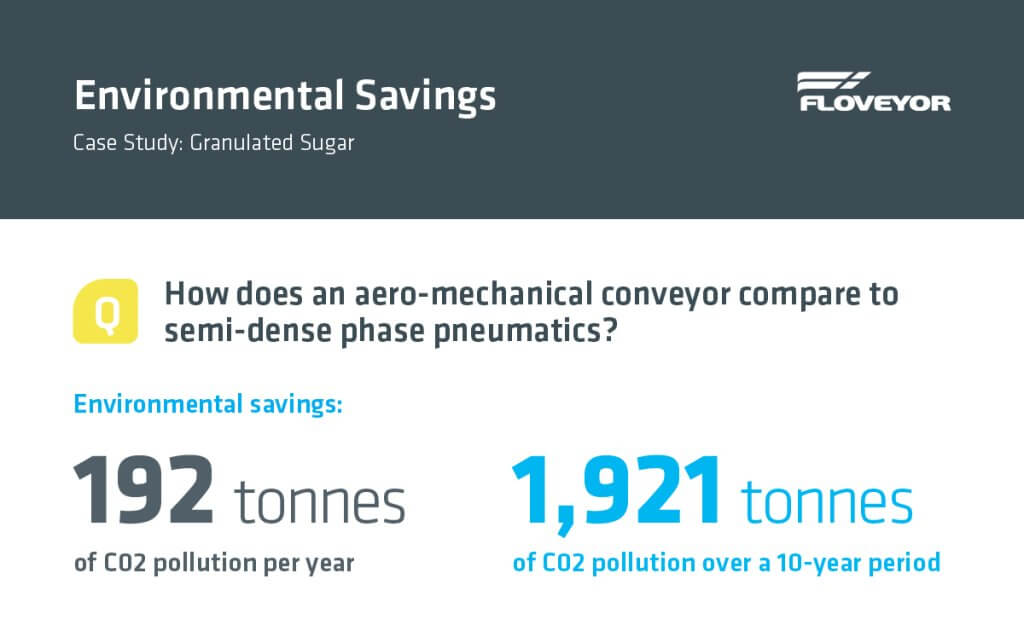
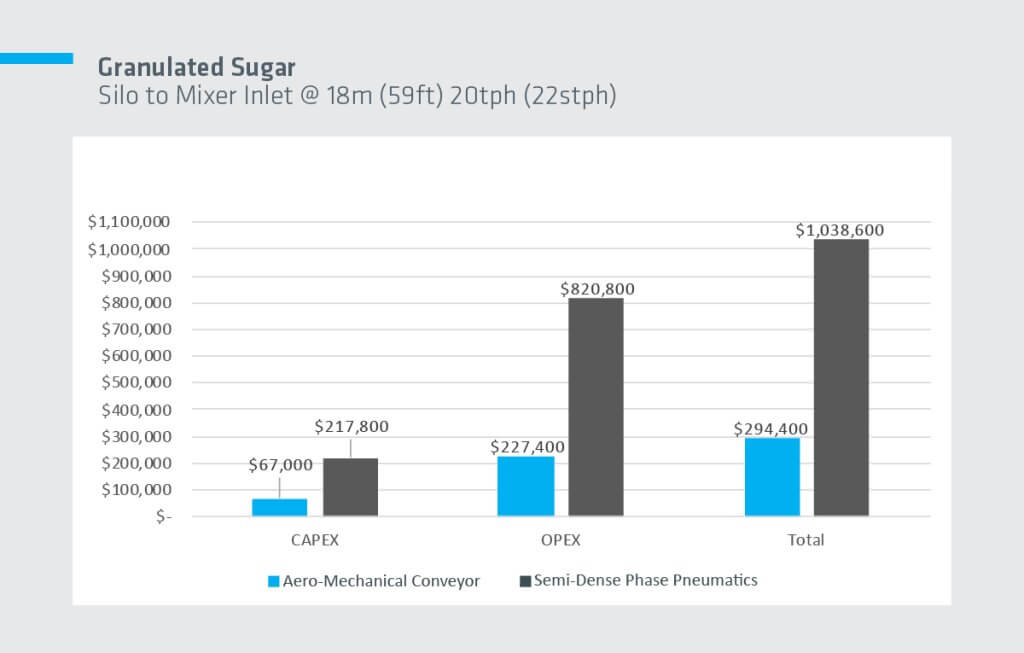
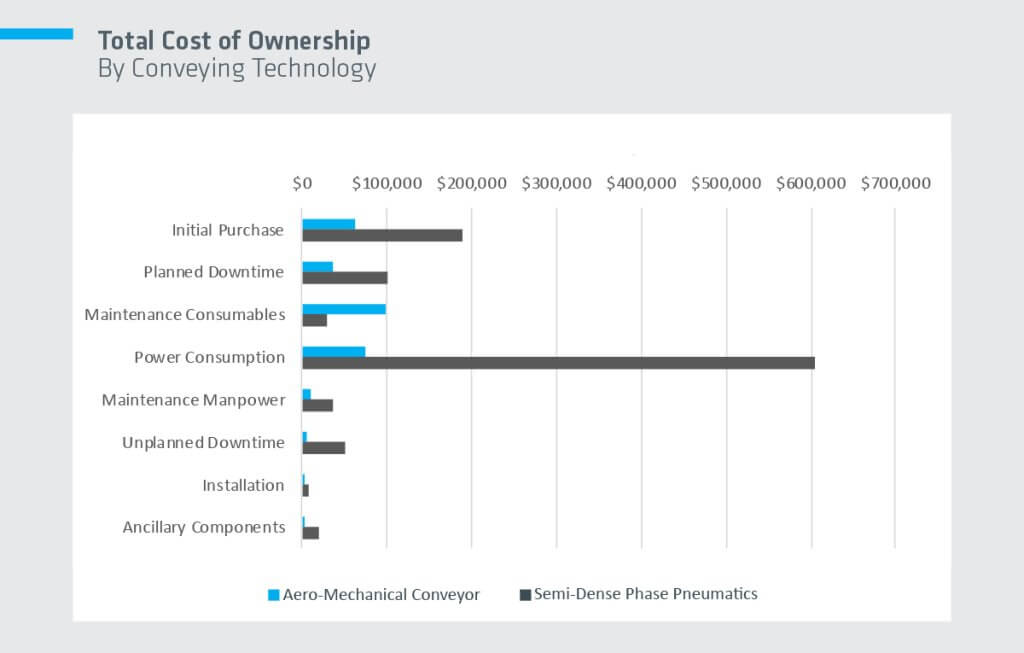
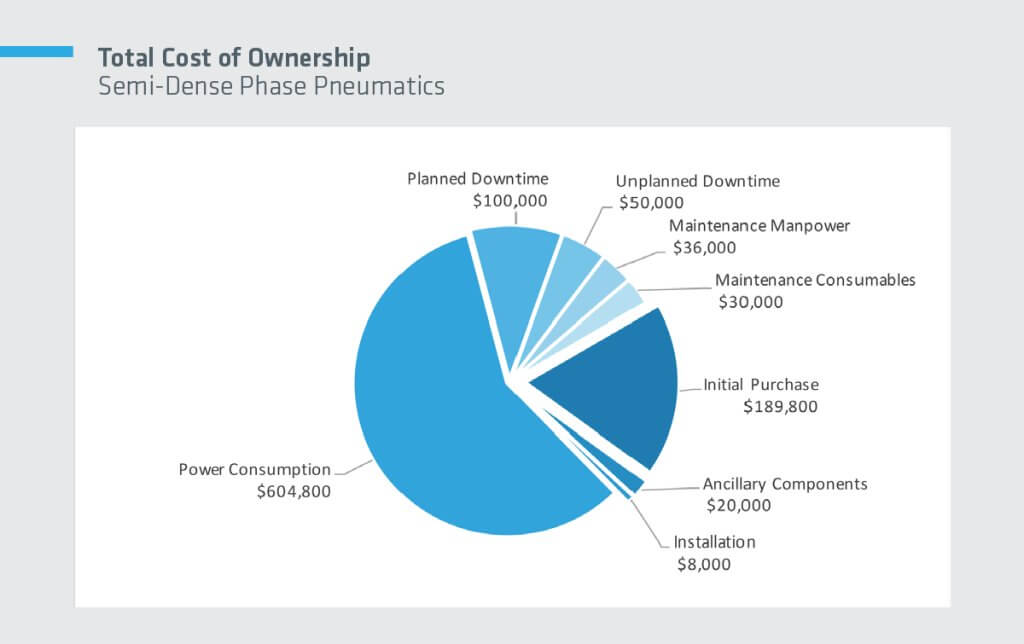
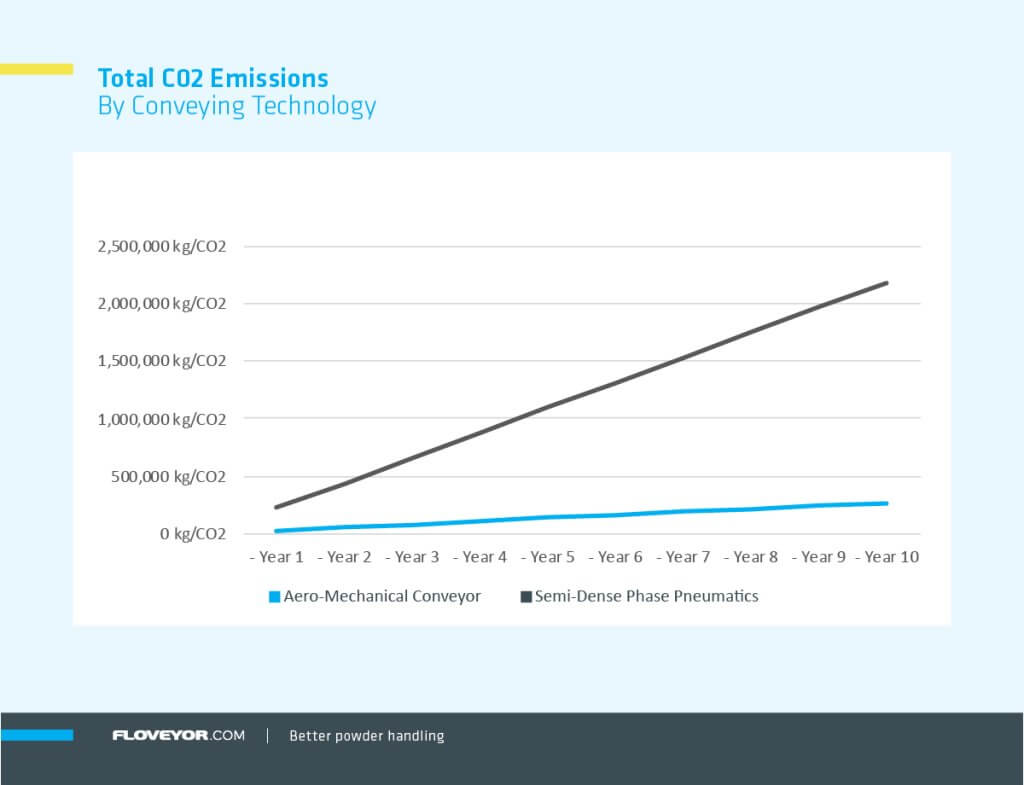
Hidden product costs of powder processing equipment
Anything that reduces yield can be a hidden cost to powder processing equipment. Consider how inefficiencies in handling can quickly add up.
Product wastage in a powder conveying system
Product wastage happens in four ways:
- Bulk materials are damaged during processing, creating product integrity problems
- Residue is left in the powder conveyor and can’t be reclaimed
- Product wastage during intake and/or discharge, due to spilling and overflow
- Separation of blends and mixes used for recipes or combined products like bird seed and fertiliser mixes.
Product contamination in powder processing equipment
Depending on the material being processed and the contaminant, your powder handling might have a small hidden cost or be completely ruined. Moisture and humidity are a nuisance for hygroscopic materials like sugar. They can cause lumping or clumping that requires additional equipment and energy to restore the material to free-flowing properties.
In the case of deliquescent materials like icing sugar, milk powder or instant coffee, too much moisture can result in your powder handling becoming an unmanageable slurry. Not only do you lose valuable product, you’ll also incur unplanned downtime while the equipment is cleaned and dried.
For other materials, like critical minerals and metals used in batteries, ferrous contamination or CO2 contamination are disastrous. These extremely high-value powders can be completely ruined.
Poor cleaning can also reduce yields during bulk material handling. High-risk foods susceptible to bacteria, gluten or other sanitary issues can result in entire production runs being lost. When this happens, unplanned downtime to eliminate contaminants in the conveyor machinery can have an impact on plant production.
How aero-mechanical conveyors contribute to better yields
Floveyor AMCs are engineered to improve sustainable conveying by improving product yields. By design, aero-mechanical conveying is focused on total batch transfers and the gentle handling of materials. This means there is minimal material left in the machine at the end of a run. Breakage and damage to materials are minuscule. Manufacturers experience little or no product wastage, which for some industries can be substantially beneficial both financially and environmentally.
Floveyor’s proprietary FloDisc Technology is directly responsible for maintaining the integrity of blends and mixes. This reduces another form of wastage that can occur due to separation during processing or packaging. Maintaining that integrity is crucial to the output for companies producing products like cake mixes or pet food.
Contamination is also eliminated with the design and engineering of Floveyor AMC machinery and equipment. We can offer assurances of cleanliness that avoids the loss of product. Our fully enclosed tubes help meet the contamination requirements of the most sensitive materials – from baby food to lithium hydroxide.
Control panel
You can select various control panel options to meet specific operational requirements. Some of the available control panel configurations include:
- Fixed speed: Provides a constant conveying rate for consistent material flow.
- Variable speed: Allows for adjustable conveying rates based on application needs.
- UL listing: Ensures compliance with safety standards set by Underwriters Laboratories.
- Explosion proof: Suitable for environments with potentially explosive atmospheres.
- Custom designs: Specific plant requirements may require design and manufacture of control panels tailored to specific end user requirements.
Hidden manpower costs
The largest expense for most companies is associated with employee remuneration including wages, benefits and insurances. Your powder handling equipment can contribute to these costs.
Worker injury
Many manufacturing and industrial processing plants around the world are facing an ageing workforce. Injuries occur at an increasing rate with age, especially those associated with lifting heavy FIBC bags. Another injury incurred in plants with powder handling is hearing damage due to excessive noise. Hidden costs can include time off work, hiring temporary workers and making workers compensation payouts.
Worker illness
Bulk material handling often involves hazardous materials which require training and care to handle safely. Dust is a culprit for many worker illnesses, especially if it’s ingested over a long period of time. Dust filters for the conveyor and PPE for workers add more OPEX to the bottom line.
Worker training
The more complex your powder processing equipment, the more you’ll have to spend to keep your operators trained on how to clean and maintain it.
How Floveyor AMCs reduce hidden staffing costs
Floveyor AMCs are designed with safety in mind. The fully enclosed tubes prevent fire and explosion that can occur when volatile materials are transferred at high throughputs. In addition, the AMC greatly reduces dust occurrence without the need for additional equipment.
Floveyor powder handling systems provide easy access for cleaning, with no tools needed. In addition, a Floveyor with FloDisc Technology requires less frequent cleaning and maintenance than comparative technologies.
Compare powder processing equipment
Review our Comparative Technologies Poster for a quick look at the costs associated with different powder handling systems or read more about choosing the right conveyor system.
Before you calculate the purchase price of your next powder conveying system, take into account the hidden costs you may experience. Only then can you calculate the potential total cost of ownership.
Learn more about hidden costs of powder processing equipment
Get in touch with Floveyor for advice on powder handling for your operation. As powder handling specialists with a long history in multiple industries, we can give you advice on total cost of ownership.

